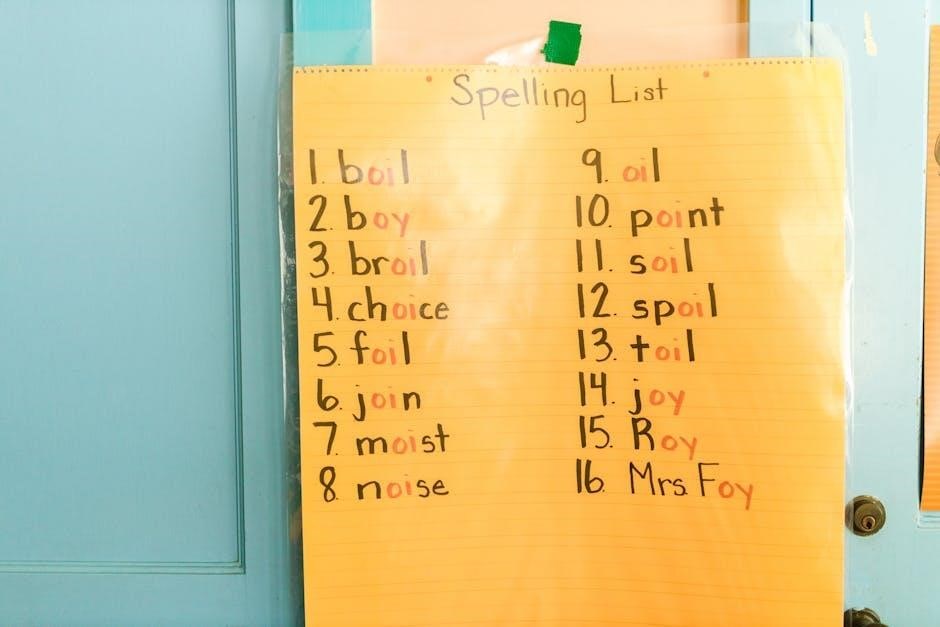The Year 5 and 6 Spelling List is a comprehensive collection of words designed to enhance literacy skills, featuring high-frequency and tricky spellings, essential for KS2 success.
1.1 Overview of the Spelling List
The Year 5 and 6 Spelling List is a curated collection of words designed to support students in mastering essential spelling skills. It includes high-frequency words, tricky spellings, and patterns that align with the National Curriculum. The list is organized to help students progress smoothly from Year 5 to Year 6, building on previous learning. Words are selected based on their relevance to everyday writing and communication, ensuring practical application. The list also features challenging spellings, such as those with irregular patterns, to prepare students for more complex vocabulary. Resources like word searches and word mats are available to make practice engaging. This structured approach ensures students develop confidence and accuracy in spelling, laying a strong foundation for future academic success. The list is widely used in classrooms and homes, making it a valuable tool for consistent practice and improvement.
1.2 Relevance in Education
The Year 5 and 6 Spelling List plays a crucial role in education by providing students with the foundational skills needed for effective communication and academic success. It aligns with the National Curriculum, ensuring that students master the spelling patterns and high-frequency words essential for their age group. The list is particularly relevant as it addresses common challenges in spelling, such as irregular patterns and tricky spellings, which are often difficult for students to grasp. By focusing on these areas, the list helps students build confidence in their writing and prepares them for the demands of secondary education. Additionally, the inclusion of resources like word searches and word mats makes the list a practical tool for both classroom instruction and home practice, reinforcing learning in a structured and engaging way. This relevance ensures that students develop strong literacy skills, which are vital for their overall educational journey.
1.3 Importance for Students
Mastering the Year 5 and 6 Spelling List is essential for students as it enhances their ability to communicate effectively through writing. Accurate spelling boosts confidence, enabling students to express their ideas clearly and creatively. The list focuses on high-frequency and tricky words, ensuring students are well-prepared for exams and future academic challenges. By learning these spellings, students develop strong literacy skills, which are foundational for success across all subjects. Regular practice with resources like word searches and spelling mats helps reinforce these skills, making learning engaging and accessible. This structured approach not only improves spelling accuracy but also fosters a lifelong appreciation for language and its application in everyday life. Ultimately, the Year 5 and 6 Spelling List serves as a vital tool for students to achieve academic excellence and personal growth.
1.4 Purpose and Scope
The Year 5 and 6 Spelling List is designed to provide students with a structured approach to mastering essential spellings, aligning with the National Curriculum requirements. Its purpose is to ensure students develop consistent spelling skills, enabling them to communicate effectively in writing. The scope of the list includes high-frequency words, tricky spellings, and patterns that build on previous learning. It is tailored to meet the needs of upper primary students, preparing them for KS2 assessments and beyond. Resources like word mats and activity sheets complement the list, offering practical tools for teachers and parents. By covering a broad range of spellings, the list ensures students gain confidence and proficiency, laying a strong foundation for future academic success. This comprehensive approach makes the Year 5 and 6 Spelling List an invaluable resource for fostering literacy development.
1.5 Sources of Information
The Year 5 and 6 Spelling List is informed by the National Curriculum, ensuring alignment with educational standards in England. The list incorporates words identified as essential for upper primary students, including high-frequency and tricky spellings. Additional resources, such as word mats and activity sheets, complement the list, providing practical tools for teaching and learning. These materials are often validated by educational professionals to ensure accuracy and relevance. The list also draws from assessment data, highlighting common spelling patterns that require focused practice. By combining curriculum requirements with real-world application, the Year 5 and 6 Spelling List offers a well-rounded approach to spelling development. This ensures that students are adequately prepared for KS2 assessments and beyond, with a strong foundation in literacy.

Structure and Format

The Year 5 and 6 Spelling List is organized into manageable chunks, categorizing words by difficulty and spelling patterns. It includes high-frequency and tricky words, such as “i before e,” to aid systematic learning.
2.1 Organization of Words
The Year 5 and 6 Spelling List is thoughtfully organized to facilitate effective learning. Words are grouped by difficulty, starting with high-frequency words and progressing to more complex spellings. Spelling patterns, such as “i before e except after c,” are emphasized to help students recognize and apply these rules consistently. Tricky and exception words, which often don’t follow standard patterns, are highlighted for extra practice. The list is divided into weekly sections, allowing for systematic practice and review. This structured approach ensures that students can build their spelling skills gradually and confidently.
2;2 Categorization by Difficulty
The Year 5 and 6 Spelling List is categorized by difficulty to ensure a gradual progression in learning. Words are divided into three main levels: beginner, intermediate, and advanced. Beginner words focus on common, high-frequency spellings, such as “friend” and “family,” while intermediate words introduce more complex patterns, like “beautiful” and “vacation.” Advanced words include tricky spellings, such as “accommodate” and “necessary,” which often pose challenges. This categorization allows teachers and students to target specific skill levels, ensuring a smooth transition from basic to more complex spellings. The difficulty levels also help in identifying areas where students may need extra practice. This structured approach supports personalized learning and helps build confidence in spelling abilities.
2.3 Format for Easy Access
The Year 5 and 6 Spelling List is designed with a clear and user-friendly format to ensure easy access for both teachers and students. The words are organized alphabetically and grouped by spelling patterns, making it simple to locate specific entries. Each word is accompanied by its definition and a sentence example to provide context, enhancing understanding and retention. The PDF is formatted with large, readable fonts and proper spacing to reduce eye strain. Additionally, the document includes a table of contents with hyperlinks to quickly navigate between sections. This format allows teachers to integrate the list seamlessly into lesson plans and enables students to practice independently. The straightforward layout ensures that the spelling list is accessible for all learners, supporting effective study habits and academic success.
2.4 Examples of Entries
The Year 5 and 6 Spelling List PDF includes detailed entries to help students and teachers understand each word’s usage. For example, an entry might feature the word “accommodate”, with its definition: to provide someone with a place to stay. A sample sentence like, “The hotel will accommodate guests during the conference,” is included to demonstrate context. Another entry could be “necessary”, defined as something that is needed for a particular purpose, with an example: “It’s necessary to bring an umbrella in rainy weather.” These entries are designed to clarify meanings and pronunciation, making learning easier. Teachers can use these examples to create practice exercises, while students can refer to them for self-study. This structured approach ensures effective learning and retention. The examples are practical and relevant, aligning with everyday language use.

Importance of the Spelling List
The Year 5 and 6 Spelling List PDF is crucial for improving literacy skills, enhancing reading and writing abilities, and fostering clear communication. It ensures academic success and long-term literacy development.
3.1 Academic Benefits
The Year 5 and 6 Spelling List PDF provides numerous academic benefits, enhancing students’ ability to spell accurately and confidently. It improves writing quality by reducing errors and ensuring clarity in expression. Mastery of these words strengthens reading comprehension, as students recognize and decode complex vocabulary more effectively. The list also supports grammar and punctuation skills, helping students understand word structure and usage. By focusing on high-frequency and challenging words, the spelling list prepares students for standardized tests and real-world communication. Regular practice fosters critical thinking and reinforces learning across various subjects. Ultimately, it equips students with the tools to express ideas clearly and effectively, laying a strong foundation for future academic success.
3.2 Long-term Impact on Literacy
The Year 5 and 6 Spelling List PDF has a profound long-term impact on literacy development. By mastering high-frequency and complex words, students build a strong foundation for lifelong reading and writing skills. Accurate spelling enhances reading fluency, as students can decode and recognize words effortlessly. This, in turn, improves comprehension and vocabulary retention, essential for understanding complex texts. The list also fosters confidence in communication, enabling students to express ideas clearly in both written and spoken forms. Over time, this skill set supports academic progression, as students tackle more challenging texts and subjects. The spelling list equips learners with the tools to navigate diverse literary genres and adapt to evolving language demands. Ultimately, it cultivates a lifelong appreciation for language and learning, ensuring students remain proficient communicators well beyond their school years.
3.3 Skill Development in Writing
The Year 5 and 6 Spelling List PDF plays a crucial role in enhancing students’ writing skills. By mastering the spelling of complex words, students develop accuracy and precision in their writing. This proficiency fosters confidence in expression, allowing learners to communicate ideas more effectively. The list introduces students to a wide range of vocabulary and word patterns, which they can incorporate into their creative and academic writing. Correct spelling also improves grammar and sentence structure, as students gain a better understanding of how words function within sentences. Over time, this leads to more coherent and polished written work. Moreover, the ability to spell challenging words reduces anxiety during writing tasks, enabling students to focus on creativity and content. This skill development lays a strong foundation for advanced writing in higher education and beyond.
3.4 Enhancement of Communication Skills
The Year 5 and 6 Spelling List PDF significantly enhances students’ communication skills by ensuring clarity and precision in their written and spoken language. Correct spelling fosters effective expression of ideas, making communication more impactful and professional. When students master challenging words, they can convey their thoughts with confidence and accuracy, reducing misunderstandings. This skill is particularly important in formal and informal settings, as clear communication is key to building strong relationships and achieving academic success. The list also introduces students to word meanings and patterns, which improves their overall language use. By enhancing spelling abilities, students develop a stronger foundation for articulating their ideas coherently. This, in turn, boosts their ability to engage effectively in conversations and written exchanges, preparing them for lifelong communication skills.

Using the Spelling List Effectively
The Year 5 and 6 Spelling List PDF can be effectively used through active recall, spaced repetition, and incorporating engaging games and interactive activities to enhance retention and enjoyment.

4.1 Effective Teaching Strategies
To effectively use the Year 5 and 6 Spelling List PDF, teachers can employ a variety of strategies to engage students and promote mastery. Differentiated instruction allows educators to tailor activities to individual needs, ensuring all learners are challenged appropriately. Incorporating multi-sensory approaches, such as writing words in sand or using flashcards, can enhance retention. Gamification, like spelling bees or online games, makes practice enjoyable and competitive. Regular formative assessments help track progress and identify areas needing reinforcement. Additionally, integrating spelling into daily routines, such as morning work or homework, reinforces learning. Teachers can also use technology, like educational apps, to provide interactive and self-paced practice. By combining these methods, educators create a dynamic and supportive environment that fosters spelling success and confidence. Consistency and positive reinforcement are key to helping students achieve their full potential.
4.2 Integration into the Curriculum
Integrating the Year 5 and 6 Spelling List PDF into the curriculum ensures spelling is taught as part of a cohesive learning experience. Teachers can align spelling activities with other subjects, such as English, History, or Science, to reinforce cross-curricular links. For example, spelling words related to a topic in History can deepen understanding and context. Spelling can also be incorporated into reading and writing workshops, allowing students to apply their skills in meaningful ways. Additionally, spelling goals can be tied to broader learning objectives, such as improving essay writing or preparing for standardized tests. By embedding spelling into the curriculum, educators create opportunities for consistent practice and application, making it an integral part of students’ daily learning routines. This approach ensures spelling is not isolated but interconnected with other areas of education.
4.3 Home Practice Techniques
Effective home practice is crucial for mastering the Year 5 and 6 Spelling List PDF. Parents and students can use various techniques to make spelling practice engaging and productive. One method is creating flashcards with the word on one side and the definition or a sentence using the word on the other. Students can also write the words multiple times, focusing on correct letter formation and spacing. Utilizing digital tools, such as spelling apps or online games, can make practice interactive and fun. Additionally, incorporating spelling into daily routines, like writing words on a whiteboard or practicing during car rides, can reinforce learning. Setting aside a dedicated time each day ensures consistency. Families can also make it a team effort, quizzing each other or competing in friendly spelling challenges. These techniques help students build confidence and fluency in spelling outside the classroom. Regular practice at home complements schoolwork and fosters long-term retention.
4.4 Reinforcement Activities
Reinforcement activities play a vital role in consolidating spelling skills for Year 5 and 6 students. These activities ensure that students retain and confidently use the words from the spelling list. Classroom games, such as spelling bingo or word races, can make practice enjoyable while reinforcing memory. Teachers can also incorporate interactive whiteboard exercises, where students drag and drop letters to form words or complete missing letters. Another effective method is peer quizzing, where students test each other using flashcards or the spelling list PDF. Group challenges, such as creating sentences with multiple spelling words, encourage collaboration and creativity. Additionally, incorporating spelling into cross-curricular activities, like writing stories or solving word problems, helps students see the practical application of their learning. Regular reinforcement ensures that spelling becomes a lifelong skill.

Key Features of the Spelling List
The Year 5 and 6 spelling list is structured to include essential spelling patterns, high-frequency words, and tricky exceptions, ensuring a comprehensive approach to literacy development.
5.1 Common Spelling Patterns
The Year 5 and 6 spelling list emphasizes common spelling patterns, such as word families (-tion, -ment, -ness, -ful, -less), silent letters, and prefix/suffix combinations. These patterns help students decode unfamiliar words, improving reading and writing skills. For example, words like “action,” “mention,” and “attention” share the -tion pattern, making them easier to spell once the pattern is mastered. Similarly, understanding prefixes like “un-” or “re-” and suffixes like “-able” or “-ment” enables students to spell a wide range of words. Teaching these patterns systematically builds foundational literacy skills and enhances vocabulary. By focusing on these common elements, students gain confidence and accuracy in spelling. This approach also supports long-term literacy development by encouraging pattern recognition and logical thinking.
5.2 High-Frequency Words
The Year 5 and 6 spelling list includes high-frequency words that students encounter regularly in their reading and writing. These words are selected based on their common usage in everyday language and academic texts. Many of these words are irregular or have unique spelling patterns, making them essential to memorize. Examples include words like “because,” “friendship,” and “language.” Mastering these high-frequency words improves students’ writing fluency and reading confidence. The list is designed to help students recognize and spell these words automatically, reducing errors in their written work. By prioritizing these words, educators ensure students build a strong foundation for clear and effective communication. Regular practice and reinforcement are key to achieving proficiency in these high-frequency spellings.
5.3 Tricky and Exception Words
The Year 5 and 6 spelling list includes a selection of tricky and exception words that do not follow standard spelling rules. These words are often irregular and require memorization, as their spelling cannot be predicted by phonics alone. Examples include words like “separate,” “necessary,” and “accommodate.” These words are strategically included to help students develop a strong grasp of unconventional spellings. Despite their complexity, these words are frequently encountered in both reading and writing, making them essential for mastery. The list categorizes these words to highlight their unique patterns, aiding students in identifying and committing them to memory. Teachers often use techniques like mnemonics or visual aids to help students remember these challenging spellings. Regular practice and targeted exercises ensure students can spell these words confidently. This focus on tricky words enhances overall spelling proficiency and preparedness for advanced literacy skills.
5.4 Progression from Previous Years
The Year 5 and 6 spelling list builds upon the foundational skills developed in earlier years, introducing more complex and sophisticated words. It reflects a natural progression from the spelling lists of Year 3 and 4, with an increased focus on words that contain more syllables, less predictable patterns, and higher-level vocabulary. This progression ensures students are well-prepared for the challenges of upper primary education and beyond. The list incorporates words that reinforce previously learned spelling rules while introducing new ones, such as silent letters, double letters, and irregular plurals. By bridging the gap between earlier years and secondary education, the Year 5 and 6 spelling list helps students develop advanced literacy skills and confidence in spelling. This structured approach ensures a smooth transition and equips students with the tools needed for lifelong learning.

Common Challenges and Solutions
Students often struggle with irregular spelling patterns, memorization, and applying spelling rules consistently. Teachers can address these challenges by incorporating interactive games, multi-sensory techniques, and personalized practice.
6.1 Common Difficulties Faced
Students in Year 5 and 6 often encounter challenges with spelling due to irregular patterns, complex syllable structures, and high-frequency words. Many struggle with homophones, silent letters, and words with multiple syllables. For instance, words like accommodate, necessary, and definitely are frequently misspelled. Some pupils also find it difficult to distinguish between similar-sounding words, such as their, there, and they’re. Additionally, students may experience cognitive overload when trying to memorize long lists of words, leading to inconsistent retention. Teachers often report that students with dyslexia or visual processing difficulties face greater hurdles in mastering these spellings.
6.2 Strategies for Different Learners
To cater to diverse learning needs, teachers can implement tailored strategies for spelling instruction. For visual learners, using mind maps, word grids, and highlighted patterns in words can enhance retention. Auditory learners benefit from listening to spelling chants, rhymes, or audio recordings of words. Kinesthetic learners can practice spelling through hands-on activities like tracing words in sand, using magnetic letters, or writing with finger paints. Additionally, incorporating technology, such as spelling apps or interactive games, engages digital learners effectively. For students with special needs, breaking words into smaller parts or using multisensory approaches like the “look, say, cover, write, check” method can be highly effective. Personalized practice lists and peer tutoring also support differentiated instruction, ensuring all learners progress at their own pace. These strategies help create an inclusive and engaging learning environment tailored to individual needs.

6.3 Motivation and Engagement Tips
Motivating students to engage with the Year 5 and 6 spelling list is crucial for their progress. Teachers can create a positive environment by celebrating small achievements and providing rewards for consistent effort. Gamification, such as turning spelling practice into games or competitions, can make learning fun and interactive. Implementing peer quizzes or class challenges fosters teamwork and healthy competition. Additionally, allowing students to track their own progress with personalized charts or journals can boost confidence and encourage self-directed learning. Incorporating technology, like spelling apps or online games, can also captivate digital-native learners. Positive reinforcement, such as stickers or praise, further motivates students to stay committed. By making spelling practice enjoyable and rewarding, educators can help students develop a love for learning that extends beyond the classroom. Engagement is key to mastering the spelling list effectively.

6.4 Overcoming Learning Barriers
To help students overcome learning barriers when using the Year 5 and 6 spelling list, educators can implement tailored strategies. Identifying individual learning needs is the first step, as some students may require additional support due to dyslexia or language processing difficulties. Multisensory approaches, such as writing words in sand or using colored overlays, can enhance retention. Breaking down complex words into smaller parts and focusing on phonics patterns can simplify learning. Providing one-on-one tutoring or small group sessions ensures personalized attention. Additionally, incorporating assistive technology, like text-to-speech tools, can aid students with visual or auditory learning preferences. Creating a supportive classroom environment where mistakes are seen as learning opportunities fosters confidence. Regular progress monitoring and adjusting teaching methods can also help students overcome specific challenges. By addressing barriers proactively, educators empower students to succeed in mastering the spelling list. Tailored interventions ensure no student is left behind.